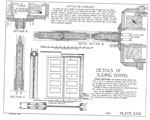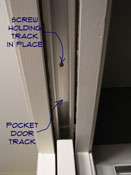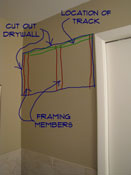
Replacing pocket door track is a repair that has some big problems associated with it. Are there replacement kits for pocket door hardware? Yes there are, see the article 'Pocket Door Hardware Kits' for more information.
Getting a kit is not the problem. Being able to install all the components of the kit is the problem.
Make sure that you can not get the door working before you pursue this option. See the article 'Lubricating Pocket Door Rollers' before proceeding. It is rare that a pocket door track would fail. See 'Tightening Pocket Door Track' for information on the one possible failure.
A 'Pocket Door Track' has (3) likely repair issues and (1) difficult choice. If you see your problem here, you can take a quick jump. Otherwise, read the overview below to zero in on your problem.
'Tightening Loose Track' - Since the track supports the weight of the door, tightening them would be a good idea. 'Lubricating Pocket Door Rollers' - The rollers ride inside the track. Sticking, frozen or noisy rollers can be a problem that is fixed quickly.
'Replacing the Rollers' - Find out the issues with matching the rollers to the track. 'Replacing the Track' - This is mostly a list of reasons why you don't want to try and do this. Find out what the issues are.
The pocket door track is found above the door, concealed in the jamb. The track spans the door opening and continues on into the cavity that is created by the pocket door frame. The door slides back and forth along the track. In fact, it disappears neatly into the wall, out of the way.
The pocket door track is sturdy enough to carry the weight of the door. The track can be different, depending on the manufacturer. The main thing to keep in mind is that the rollers are matched to the track. The track has grooves for the rollers to ride along. The weight of the door rests on these grooves via the rollers and hangers.
The track itself does not have any moving parts. Therefore it is fairly sturdy and rarely needs any attention or repairs. The exception to this rule would be when the track is not installed properly. The track needs to be installed securely to the door head. A track that loosens up will need to be tightened up.
What Can You Save? - There is not a lot that can go wrong with the track itself. When it works loose it needs to be tightened. This could run $50 to $75. When the rollers seize up you need to replace the track and the rollers at the same time. This could run $100 to $200.
How Hard Could It Be? - Tightening a loose track is not too difficult for the exposed portion. The hidden section is another story. Replacing a pocket door track is a fair amount of work. It may involve cutting out some drywall to get at the concealed end of the track.
Check the Simple Things! - Try lubricating the rollers before you do anything else, this is the solution most of the time.
What Can Go Wrong? - Replacing the track may involve cutting out some drywall to allow you to get at the screws. Patching drywall is a messy job and you have to paint the wall after your done. This is after you have removed the door and set it aside. This will be more than an afternoon job.
Pocket Door Track - How It Works
The pocket door track is usually an aluminum extrusion. They can be "C", "T", "F" shaped depending on the age of the door and the manufacturer. The important thing to remember is that, the rollers have to match the track.
The rollers run along grooves in the track, allowing the door to slide back and forth. This is what gives you that feature of the door 'dissappearing into the wall'.
The pocket door track is usually installed during the construction phase. When the walls are open, fastening the track is no problem. After the drywall is installed, access to the narrow 'pocket' is severely restricted.
The track is cut short of the door frame to allow for the removal of the pocket door rollers. The track is generally installed with wood screws that go into the head portion of the frame.
Tightening Loose Track

The pocket door track is attached to the head of the frame with screws. The problem with this is that the track is twice as long the door opening. Half of the track is hidden inside the pocket. Making the screws difficult to get to and even harder to tighten.
The first thing to try is to tighten the screws you can get to. Move the door all the way into the pocket and you will be able to see the track. Most pocket door tracks are held in place by five screws. You should be able to get to three of them from the open doorway. See if this tightens the track up sufficiently.
Cutting a hole in the drywall is an option, if you have to get at the concealed screws. Cut a twelve inch long by six inch high hole in the approximate center of the pocket. Cut the hole three or four inches below the top of the door. Try to save the piece of drywall for the patch later. For information on installing a drywall patch, see the article 'Repairing Drywall Holes'. This article has some instructions on how to cut out the patch and repair it afterward.
With the hole cut in the drywall you should be able to get at the screws to tighten them. Move the door out into the opening before you attempt this. You may need a flashlight to see the screws. Make sure the pocket door track is secure before you close up the hole in the drywall. Patch the drywall and paint the wall. That sure is a lot of work to tighten a couple of screws.
WARNING!! A pocket door can be heavy and awkward to handle. Get Help Before Attempting to Remove It!!! WARNING!!!
Replacing Pocket Door Track
 If you can get to it, replacing pocket door track is simple. A few screws and that's it.
If you can get to it, replacing pocket door track is simple. A few screws and that's it.
Generally, the length of the track is set by the door size. A 2' 6" door will have have a track that is approximately 58 1/2" long. The length of the track is determined by doubling the door size and then subtracting a relief space of around 1 1/4" to 1 1/2".
The relief space is to get the rollers in and out, once the framework is installed. The track is installed tight to the inside end of the pocket and the relief space is left at the open, strike side jamb.
The track is usually cut to length when you buy the kit. Again, the kits are sized by the size of the door. See the article 'Pocket Door Hardware Kits' for more information on what's available.
Accessing a Pocket Door Track
You do not need to take the door completely apart. You do need to be able to get at the top sixteen inches of the pocket to access the screws.
There is some good news. You only need to get at one side or the other. The bad news is that this will involve cutting out some drywall. The drywall will need to be patched, taped, mudded and painted.
Are you sure you want to do this?
Cutting Out the Drywall
 You need a 16" x the Width of Door opening to access the back half of the track. See the articles in the segment on 'Drywall Patching', especially the article on 'Repairing Big Holes in Drywall', for more information. After the patch is installed, you will want to see the article 'Taping and Mudding Drywall' for tips on how to finish the wall.
You need a 16" x the Width of Door opening to access the back half of the track. See the articles in the segment on 'Drywall Patching', especially the article on 'Repairing Big Holes in Drywall', for more information. After the patch is installed, you will want to see the article 'Taping and Mudding Drywall' for tips on how to finish the wall.
Once you have cut out the drywall, you should be able to see the track and get at the screws.
Removing the Track
Now that you can get at it, removing the track is easy. Use a battery drill and bit holder or a screwdriver to remove the screws.
Have someone hold the track before you remove the last couple of screws. No need to damage the floor by letting the track fall down.
Installing a New Pocket Door Track
The track should be already cut to right length for your door size. It should be slightly shorter than the overall length of your header (approximately 1 1/4" to 1 1/2" shorter). Remember, the relief to install the rollers is at the end by the door strike. The track should go tight to the frame at the inside of the pocket.
The track should have holes at the proper locations for the screws. Just follow that pattern.
Align the track in the center of the header. Keep it parallel the entire length of the header. The track needs to be installed with the 'relief area' at the strike side of the door frame. This allows for the installation of the pocket door rollers.
Summary
Did dealing with your pocket door track turn out to be a big problem? That is certainly not good news. The track is durable and normally problem free. Poor installation may have been the reason you had a problem. A lazy carpenter could be to blame.
Seized up rollers would be the other troublesome situation. A lack of maintenance would cause the rollers to tighten and eventually quit working. Maybe you where able to free them up with some oil. What a relief that was. Were you able to find replacement rollers? Or did you have to buy a whole kit. Hope everything turned out well, now for another repair task.